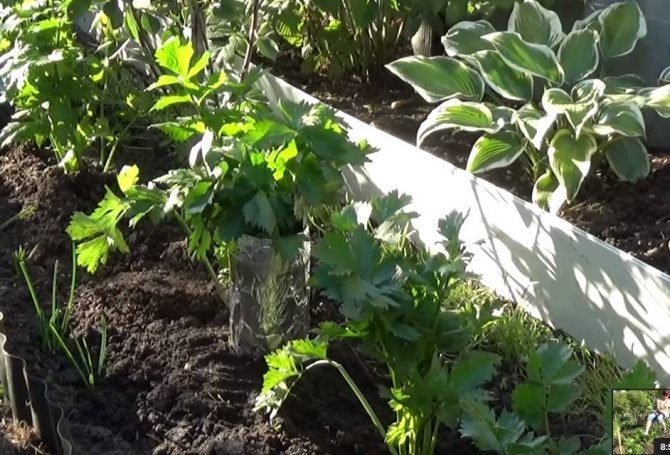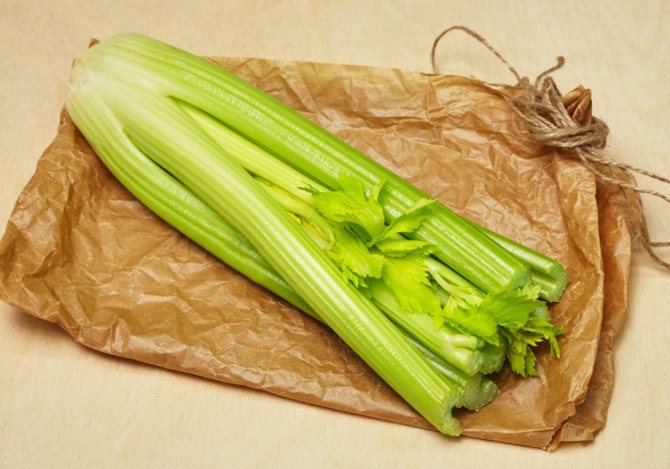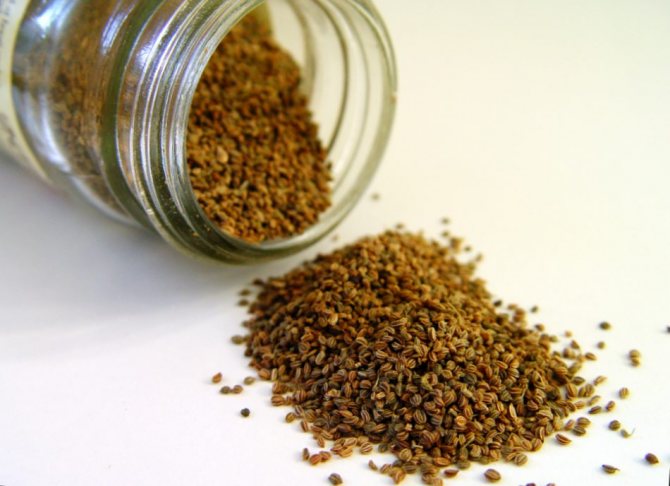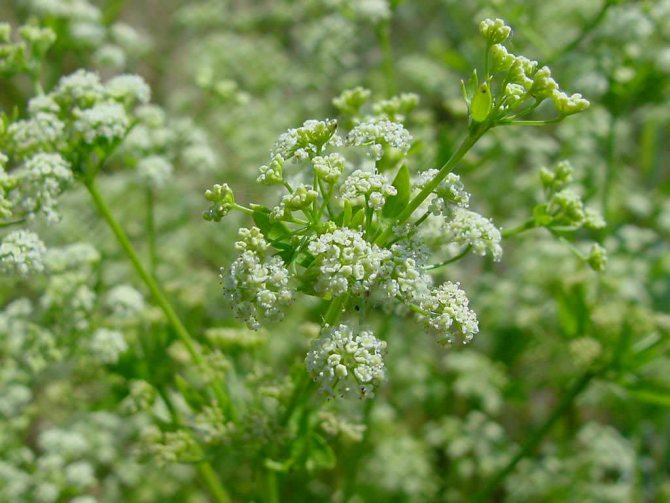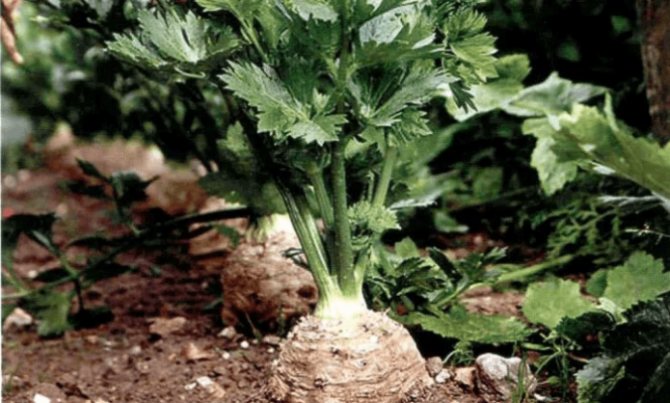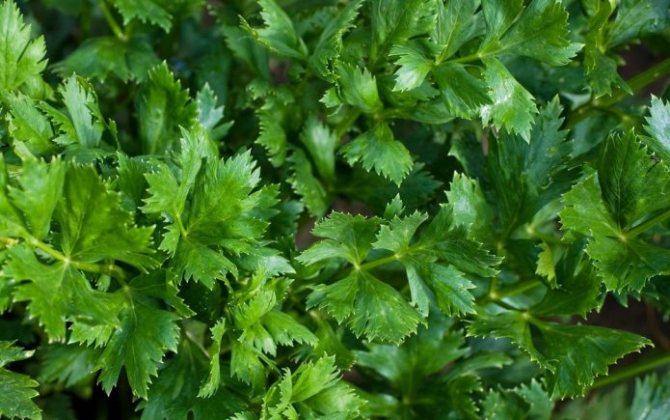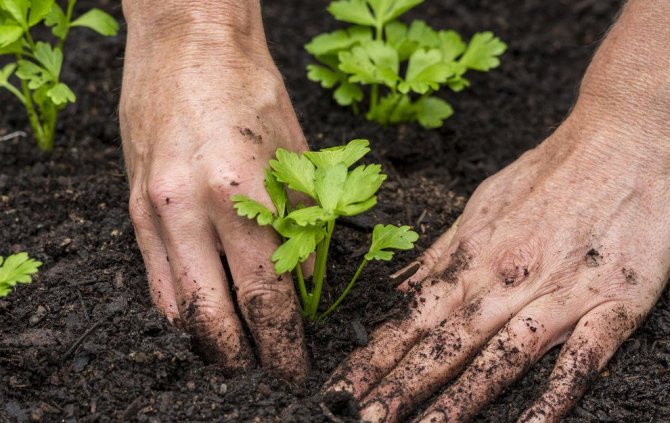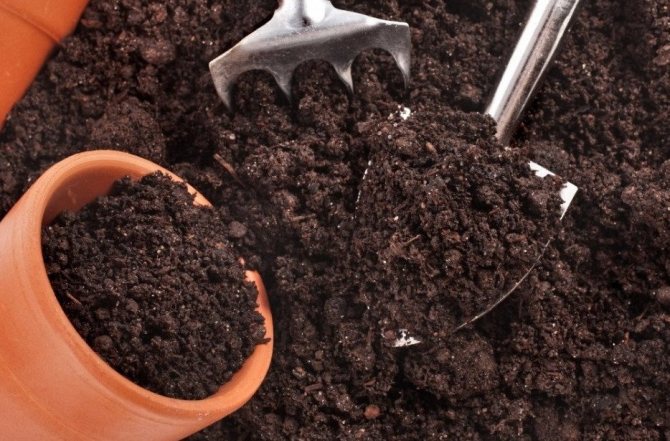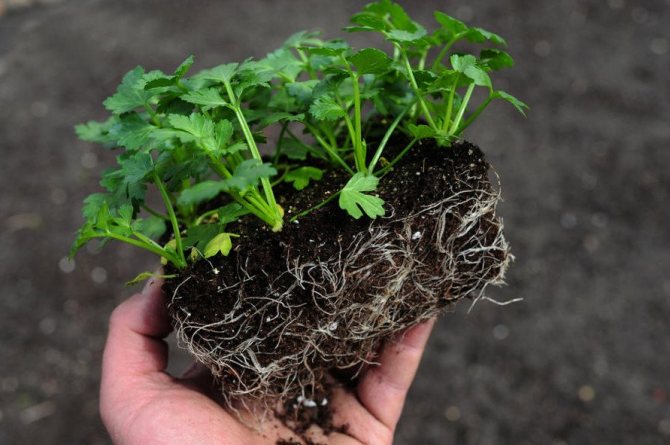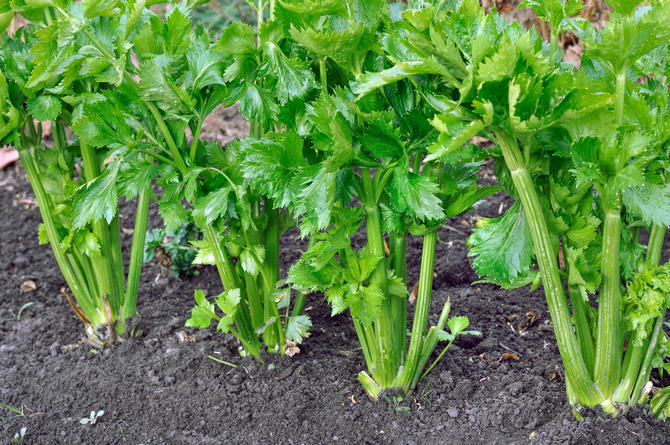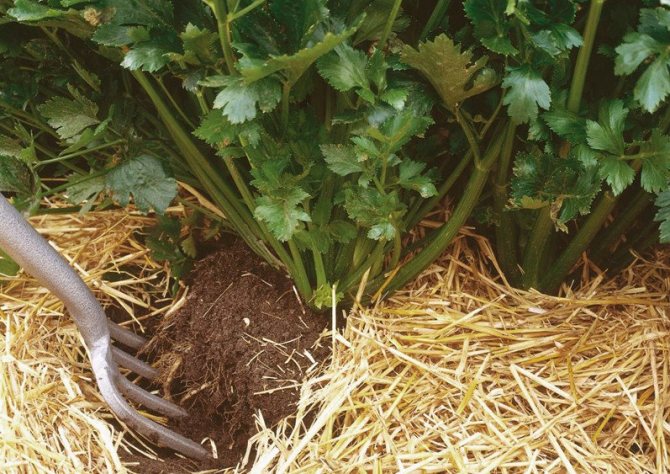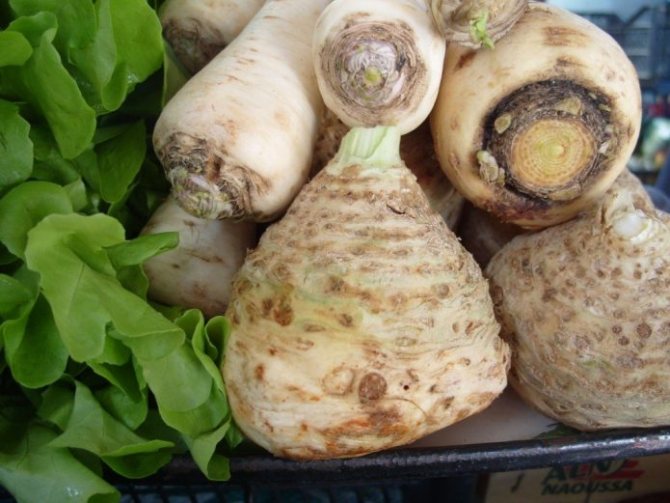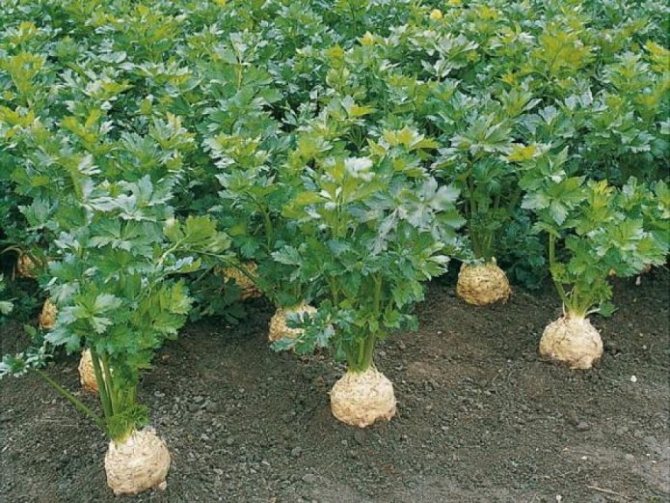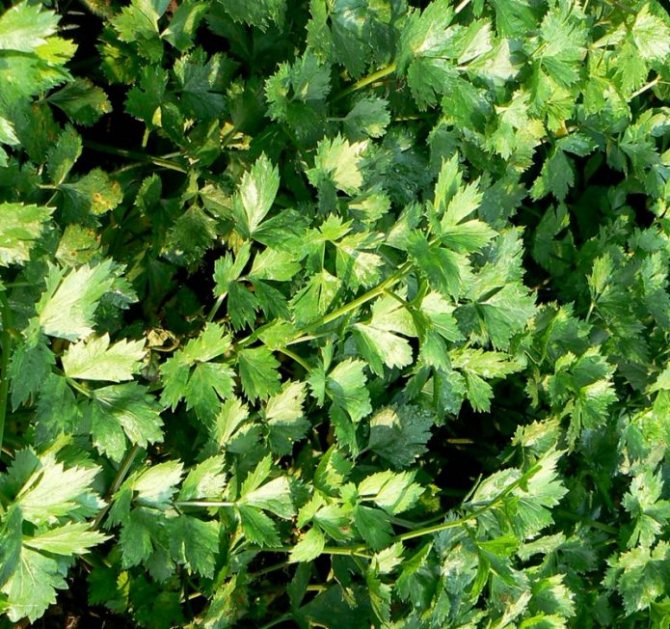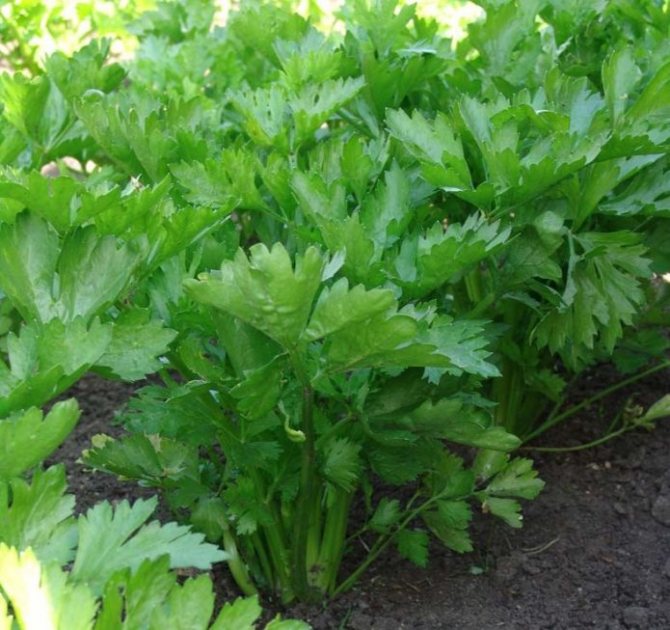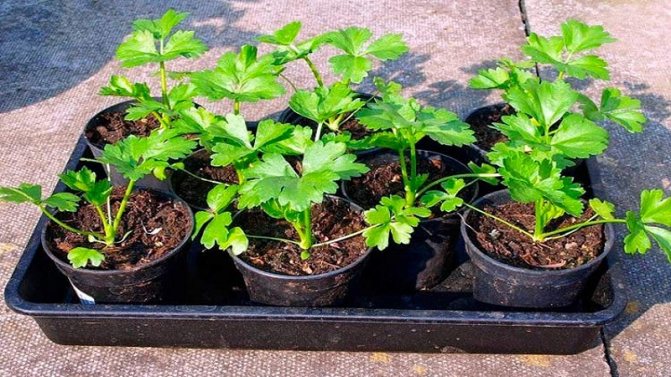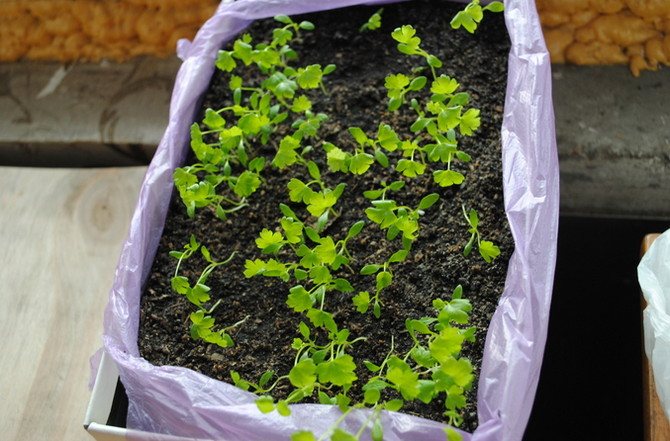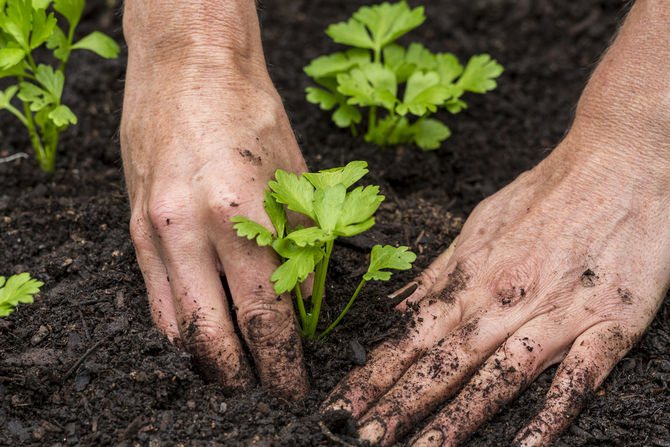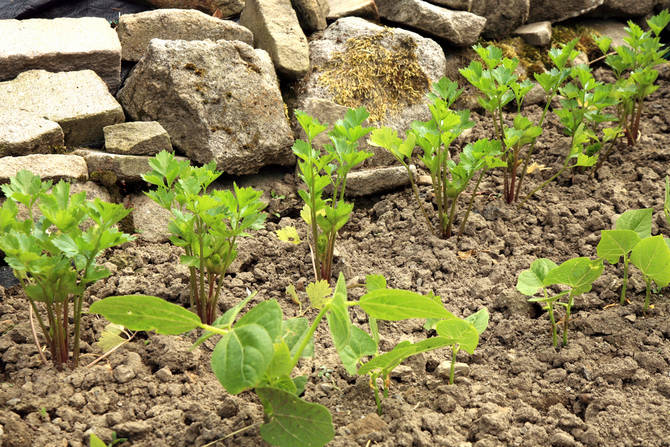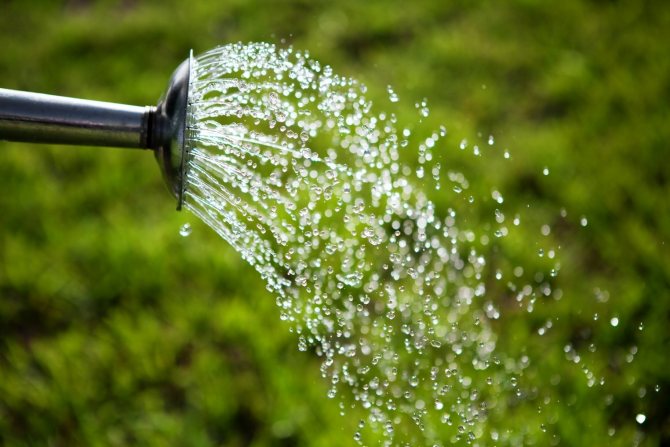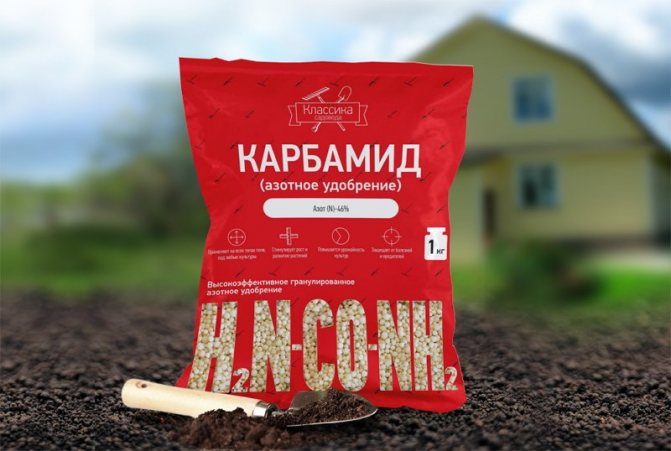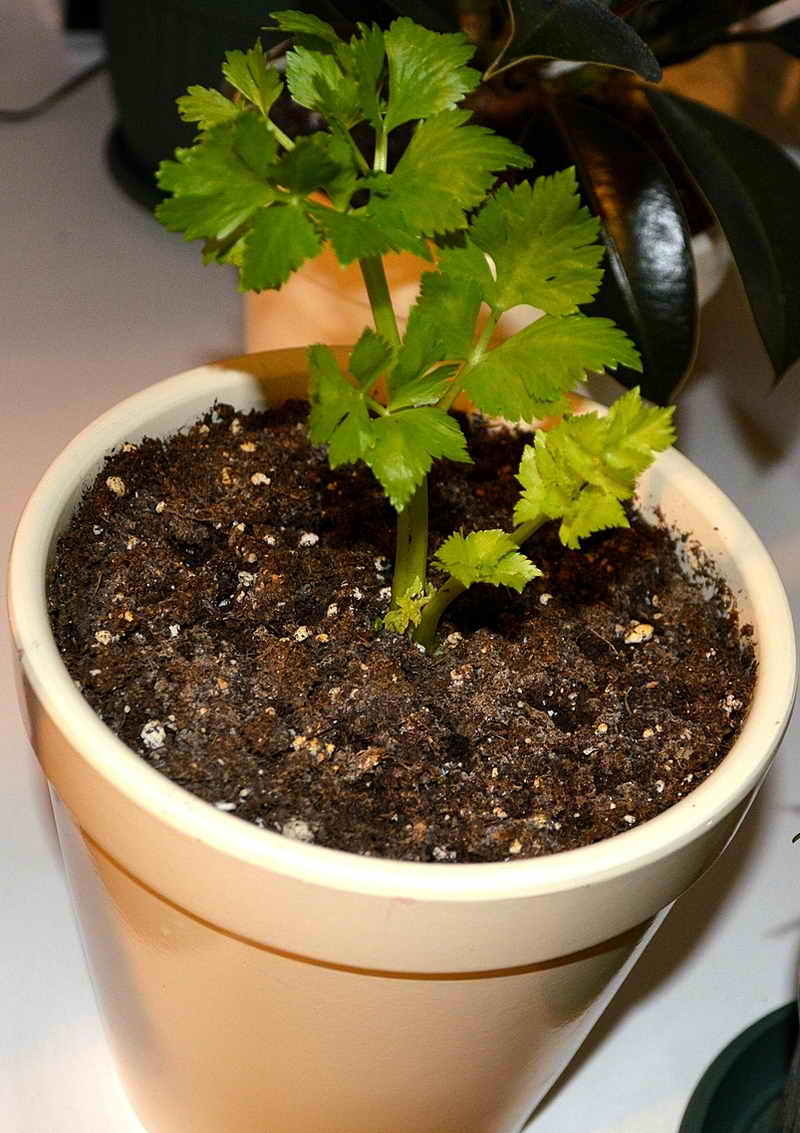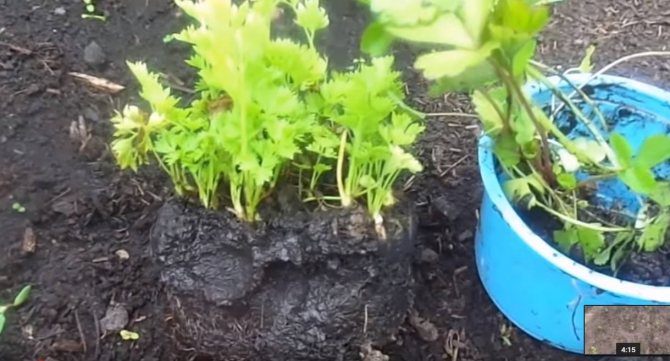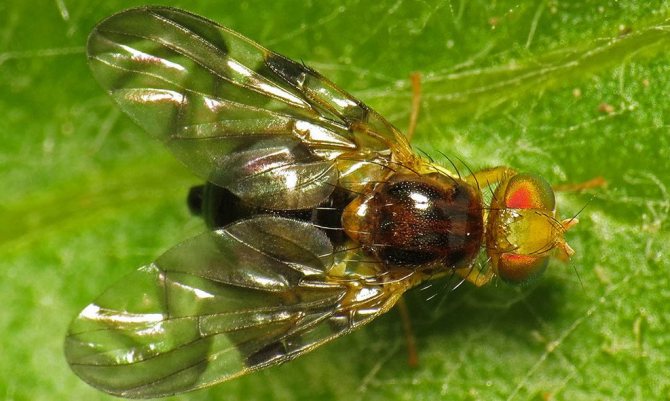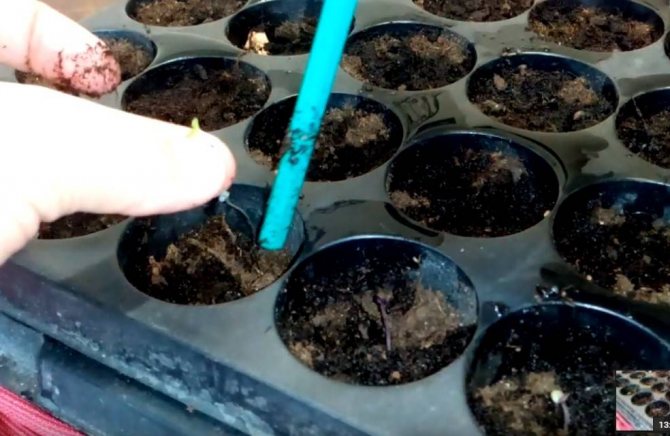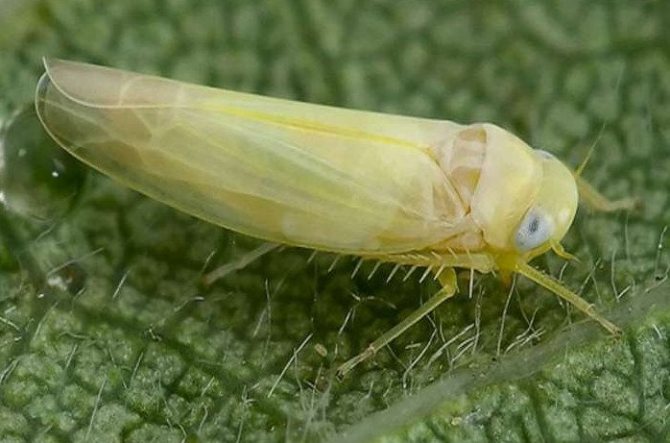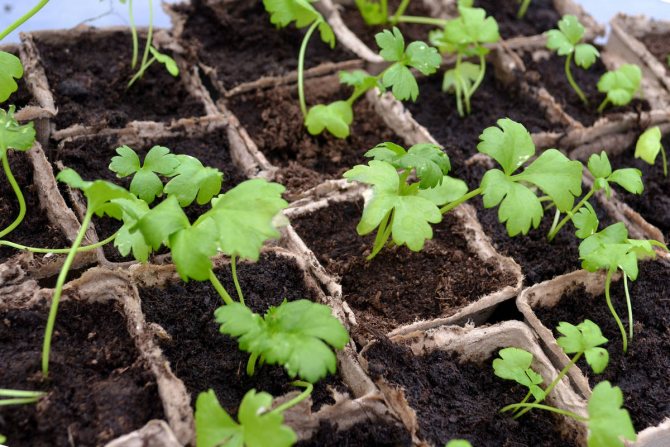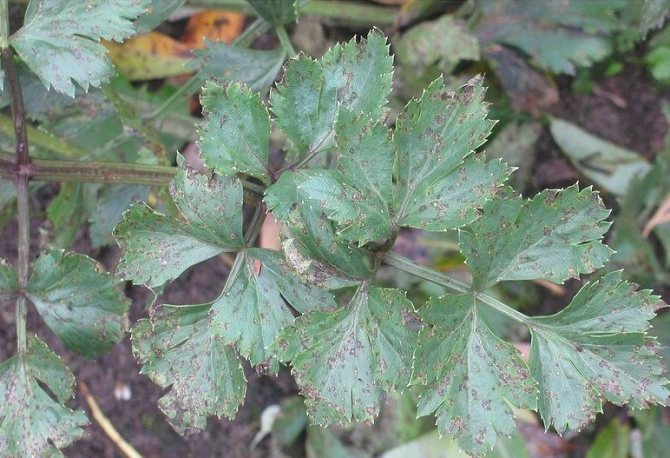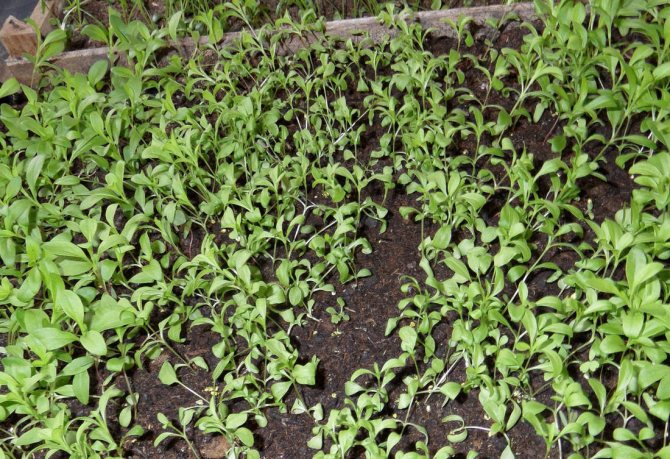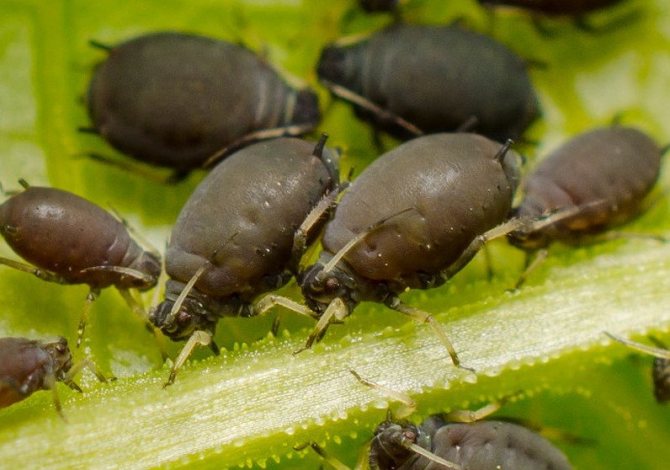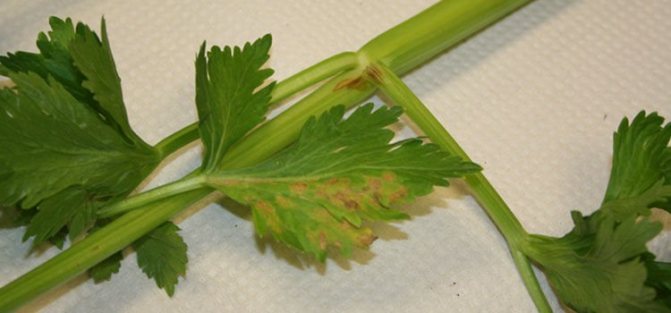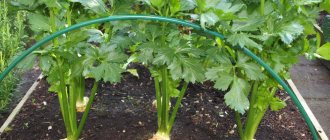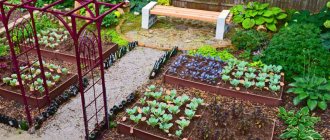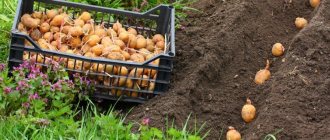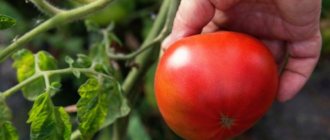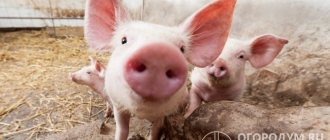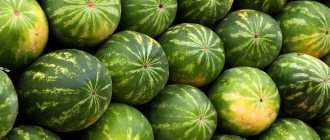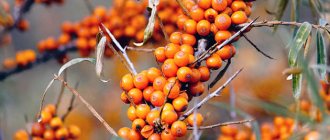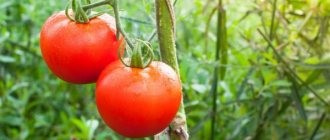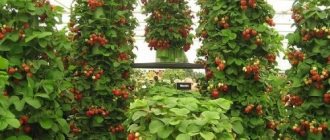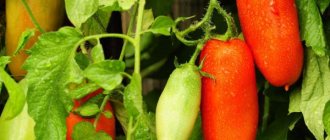How to properly grow stalked celery
It is quite simple to grow stalked celery in the country or on the site, if only because you do not need a lot of it, which means that each leaf outlet can be given due attention.
- It is impossible to grow juicy and tasty celery stalks without timely watering. With a lack of moisture, they will turn out to be dry, and hard fibers will be present in their structure. With excessive watering or during prolonged rains, the plant is threatened with rotting of the core, or the so-called growth point.
- Regular loosening of the soil will help to avoid stagnant moisture, and weeding will relieve the attacks of pests.
- Petiole celery needs regular feeding with organic fertilizers. But here, too, there are a few things to keep in mind. Excess nitrogen compounds often lead to cracking of celery stalks.
- The agrotechnics of cultivation of petiole celery includes the implementation of such unusual measures for most plants as bleaching the petioles. For this, a regular hilling of the plant is carried out. It is under a layer of soil and without access to light that the petioles acquire their delicate and piquant taste and lose their bitterness. To avoid this event, self-bleaching varieties should be planted. For example, Malachite or Pascal.
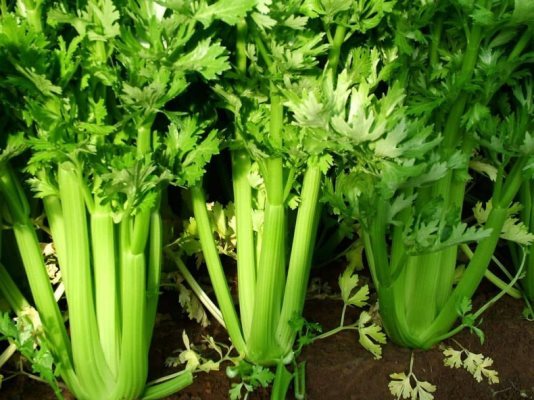
Apart from the bleaching stage, the rules for growing and caring for stalk celery are quite standard. Any plant requires watering, feeding and weeding the ridges.
Ingredients: vitamins and minerals
The calorie content of celery is approximately 13 kcal per 100 grams. The energy value of the roots is 32 kcal per 100 grams. Celery stalks contain some form of salt, so eating that amount of the plant is problematic. Even dieters are more likely to neglect numbers:
- 0.9 g protein;
- 2.1 g carbohydrates;
- 0.1 g fat.
All parts of celery contain minerals and vitamins:
| Substance | Quantity per 100 grams | Minimum amount for 1 day for an adult | Main function in the body |
| Vitamin A | 0.01 mg | 0.6 mg |
|
| Vitamin B1 | 0.03 mg |
|
|
| Vitamin B2 | 0.05 mg | 1,5 mg | Required for:
According to some studies, it prevents the development of cancer. |
| Vitamin B3 (PP) | 1 mg | 1,4 mg |
|
| Vitamin C | 8 mg |
|
With a lack of vitamin C, the following deteriorate:
|
| Calcium | 60 mg | 1000 mg | Indispensable in:
|
| Magnesium | 30 mg | 400 mg | Participates in almost all body processes. Needed for
It works against allergies and improves intestinal motility. Serves for the prevention of diabetes and kidney stones. |
| Potassium | 390 mg | 2500 | Regulates:
|
| Phosphorus | 27 mg | 800 mg | It is part of bones and teeth. Without phosphorus, they become brittle. Affects nerve impulses, muscle contractions and mental development in children. |
| Sodium | 75 mg | 1300 mg | Maintains normal osmotic pressure. Required for work:
Together with chlorine, sodium forms hydrochloric acid in the stomach. |
| Manganese | 150 mcg |
|
|
| Iron | 0.5 mg | 18 mg | It is necessary for the synthesis of hemoglobin (the transfer of oxygen by the blood). Takes part in the synthesis of many enzymes. |
| Zinc | 0.3 mg | 12 mg | Zinc deficiency leads to short stature, head enlargement and infertility. It is required for:
|
The plant also contains glutamic and niacin.
Due to the use of celery, it will not be possible to compensate for the deficiency of all nutrients, but as a prophylactic agent it is ideal. Periodic addition of this plant to the diet will help to avoid vitamin deficiency in the off-season.
The beneficial properties and contraindications to the use of celery are associated not only with the presence of vitamins and minerals in it. The plant contains a complex essential oil. Excessive consumption of it lowers blood pressure and causes allergies, therefore, it is not worth gaining a daily intake of vitamins with celery.
Features of growing stalked celery, depending on the variety
It should be noted that breeders do not stand still and are trying to keep up with the increasing demand and requirements of gardeners for each crop. Stalked celery was no exception. Every year new varieties appear, and, therefore, the rules for its cultivation change somewhat.
- Atlant is considered one of the best varieties among gardeners. It is appreciated for its excellent delicate taste and long shelf life. The variety is late ripening, ripens in at least 5 months. Therefore, it is grown exclusively in seedlings and needs bleaching.
- Royal is one of the most productive celery varieties. The weight of one bush can reach 700 grams. Although considered mid-season, with a maturity of around 4 months, it is preferred to grow it through seedlings. The petioles must be bleached.
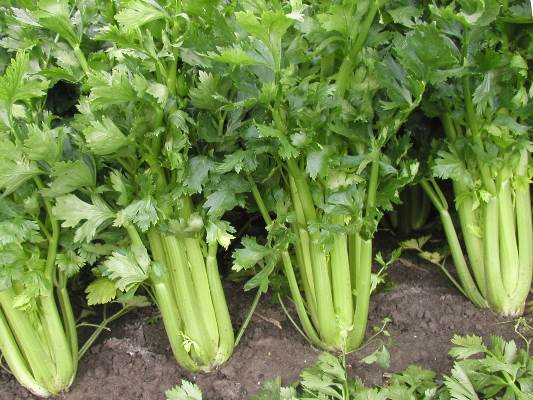

- Utah also belongs to the celery varieties that require a procedure such as bleaching. Differs in its original appearance. The stems are light purple or purple in color and contain few fibers.
- Crunch is one of the cold-resistant celery varieties. Its cultivation is possible in the harsh conditions of Siberia and the Far East. Requires bleaching to enhance palatability.
- The yield of the self-bleaching Pascal variety pleases - from 3 to 5 kilograms of juicy stems per square meter. However, rather long ripening periods and thermophilicity do not allow organizing the cultivation of Pascal stalked celery from seeds by sowing directly into the ridges.
- Tango belongs to the varieties that do not require bleaching. Cold hardy and mid-season, it can be grown in greenhouses or outdoors. Well tolerates short-term night frosts down to –1˚ – 3˚C below zero. In the greenhouse, it is possible to sow with seeds in the ridges.
- One of the rare varieties of stalked celery that can be grown by sowing in ridges is the self-bleaching Malachite variety.The early maturing and cold-resistant variety is also distinguished by its high yield. The mass of one leaf outlet reaches one kilogram.
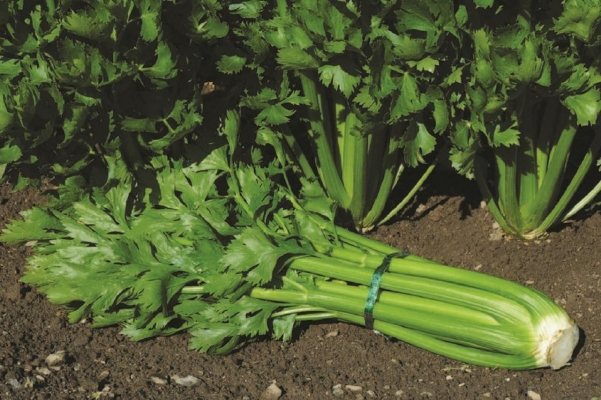

Attention!
The choice of a variety depends on the grower, his taste preferences and the ability to organize proper planting care. If there is no desire or time to grow petiole seedlings from seeds and bleach the petioles, you should give preference to early-maturing, self-bleaching varieties.
Growing celery in the country: advice from experienced gardeners
Cultivation of celery in the country It is not difficult to grow celery in the country, which means that we can adopt the advice of experts, master agricultural techniques and start work that promises us good results. So, growing celery at DachaDecor.
Perhaps, it is worth starting with what celery is. It is a member of the Umbrella family, a vegetable and a herbaceous plant that can be biennial or perennial. There are more than twenty plant species around the world, but only a few are considered the most popular among them.
Most often, in our country, a biennial celery plant is grown, which bears fruits in the form of roots and greens in the first year, and in the second - celery blooms and forms a fruit with seeds.
Types of celery
First of all, I would like to designate main types of celerywhich we will talk about today. These are leaf celery, stalked celery and root celery.
Growing leaf celery makes it possible to get green and juicy leaves of the plant, which can be cut off throughout the warm period.
Cultivation of stalked celery practiced by summer residents, as well as large trading enterprises that work with fresh herbs to get juicy plant stalks for preparing a variety of dishes and even alcoholic cocktails.
Growing root celery, helps to get the roots of the plant, respectively, which in a good season can be up to 600-800 g per plant.
Celery varieties for summer cottages
Choosing a variety of celery, each person is guided strictly by his own requirements, because each individual variety differs not only in appearance, but also in taste and field of application of the plant.
At the moment, quite a few separate varieties of celery are known, but the following are in greatest demand:
- Leaf celery - Gentle, Kartuli, Vigor, Zakhar;
- Petiolate celery - Jung, Malachite, Gold, White feather;
- Root celery - Maxim, Diamant, Esaul, Gribovsky, Apple.
Among the presented plant varieties, you can choose absolutely any, since by creating certain conditions and observing the agricultural technology of growing celery, you can get good results. But pay attention to which plant variety suits you best, early or late.
Which celery to choose for growing on your own plot?
How to grow celery in the country?
When it comes to growing celery in general, the plant prefers quiet places with fertile soil and good lighting. But, it is quite real and a good harvest on slightly acidic soils, in partial shade, in this case you will not lose in the harvest, but only get some of its changes, for example, a change in the aroma of celery leaves.
Growing leaf celery
Leaf celery is considered a fairly cold-resistant plant that can tolerate frost or even winter in adult form without loss. At the very beginning of its development, celery grows poorly, and this is very noticeable. This is due to small seeds and their not very good germination, and therefore, experienced summer residents prefer growing leaf celery with seedlings.
Seed preparation
In order to change the germination of leaf celery seeds for the better, they must be prepared. To do this, the seeds are soaked in a special solution, for example, in a weak solution of potassium permanganate, and left for several hours. After that, the seeds are germinated on moistened gauze for several days.
Sowing leaf celery seeds
When the seeds are prepared, they can be sown in a special soil mixture. The best for this is a mixture of sand, leafy earth, humus and peat, in a ratio of 1: 1: 1: 1. Sowing is carried out in early March, in ready-made wooden boxes with the specified soil mixture. Seeds should be sown shallowly, covered with peat powder. Further, for almost a week, while the seeds do not germinate, you will need to maintain a stable ambient temperature within + 17 + 20 ° С. After the seeds sprout, the temperature should be lowered to + 15 ° C. Growing seedlings of leaf celery requires a clearly normalized daylight hours, a certain temperature regime and accurate, timely watering (preferably through a sieve), only in this case the seedlings will be strong and suitable for transferring to open ground. If you make mistakes, the greens can just grow. At the moment when a young plant gives two true leaves, it should be dived with a pinch of the main root, which will contribute to the confident development of the root system of celery seedlings. Transfer to open ground occurs in April or early May, the planting pattern for leaf celery is 25-25 cm.
Plant care
Celery growers argue that the plant must not be planted very deeply in the soil so that the growing point is on the surface. After planting, the very caring for the celery is very simple and does not steal a lot of time.
First of all, watch out for the timely harvesting of weeds between the rows of planted plants, as well as for systematic watering. So that a crust does not form and stagnate on the surface of the soil, which does not benefit the celery, it is constantly loosened, preferably after each watering. But, in order to reduce time costs, you can mulch the soil, which will enable it to retain the amount of moisture necessary for the growth and development of celery, exclude the lush vegetation of weeds inside the celery garden, as well as the formation of a crust. Adhering to the correct technology for growing celery, you can harvest in mid-July - early August.
Growing leaf celery in the country
Growing root celery
Due to the very long growing season, it is advisable to grow celery root only by the seedling method. Growing root celery from seeds is almost the same as leaf celery, you only need to plant the crop a month earlier, having prepared the seeds well beforehand.
Also, there are certain features of growing celery root, including double picking during transplanting seedlings, proper preparation of seedlings and fertilizers to enhance growth and harvest strength for the season.
We also recommend that you think about the very type of plant from which you need the root. Of course, during the growth process, you can also collect celery leaves, but it is worth limiting the amount of collection to a minimum, since only at the end of the season, the main organic matter from the leaves will begin to accumulate in the roots. Otherwise, it will not be possible to get a good harvest.
Root celery care
Growing root celery from seed is almost impossible, or at least not particularly interesting, and therefore, using the cultivation of root celery from seedlings, you must be very careful and careful to get decent results of your work.
Grooming is practically the same as caring for leafy celery, which means loosen the soil and systematically water the plants, arrange mulch in the celery garden and remove weeds that may appear near the planting.
The cultivation technique of root celery has some peculiarities, and the most important of them, which can affect the quality of the root crop, is the hilling of the fruit during growth. This is strictly prohibited, it is even recommended to cleanse the upper part of the root crop from the soil.
Harvesting root celery requires some preparation. 15-20 days before the start of harvesting, it is necessary to break off the lateral leaves of the plant, and even more to shake off the soil from the top of the fruit. Further, after the required period has expired, by about mid-October, you can begin to harvest the celery root.
Growing celery root, basic principles
Cultivation of stalked celery
Initially, growing stalked celery from seeds into seedlings is no different from growing leaf celery, but then, already when planting seedlings in open ground, there are some peculiarities.
The seedlings are transferred into the ground, into grooves that exceed the planting depth of leaf celery, their depth is about 10 cm.The apical bud is also not covered with soil, but after the beginning of intensive growth, when the celery stalks begin to thicken significantly, hilling is carried out. Throughout the growing season, even several hillocks are possible.
Thus, juicy green petioles are freed from possible bitterness and become more tender, the cultivation method has the original name - petiole bleaching. Whitening is supported by another special technique: 12-14 days before harvest, the petioles are tied into a single bundle and wrapped in paper, while the celery is removed before freezing.
Thus, the cultivation of petiolate celery from seedlings, general agricultural technology and harvesting practically do not differ from other types of celery, except for the moment of hilling and wrapping with paper for bleaching.
Celery stalk: planting, care, harvesting
Diseases and pests
Growing celery from seed to seedling, cultivating stalk celery, or even subsequent cultivation of celery root can be offset by pests and diseases that attack the plants throughout the ripening period. Correct agricultural technology, as well as prevention, can resist them.
To prevent the spread of bacterial spotting, heart rot, white stem rot, viral mosaic, black leg and celery stalk base rot in the garden and in plants, it is necessary to strictly adhere to the basic norms of plant cultivation. Among them, only timely watering, the exclusion of waterlogging of the soil, thickening of the planting, as well as the spread of weeds in the bed. Common celery pests can also be carriers of diseases: scoops, carrot fly larvae, various snails and slugs, which should be disposed of in time by prevention and spraying.
Also, planting mixed with other herbaceous plants or vegetables can be an excellent method of preventing crop loss.
Celery growing video
If you raise the issue of growing celery in different regions, for example, growing celery in the Moscow region or Siberia, then you can come to only one opinion - correct agricultural technology will allow you to get a good harvest almost everywhere... Naturally, some climatic conditions are not quite suitable for growing this crop, but then you can grow celery at home - prepare seeds, grow seedlings, apply a transplant, provide care and get the desired harvest.
Weeding, loosening, mulching
During the cultivation period, stalked celery needs timely weeding and loosening of the soil. Weeding is done as needed. Loosening is carried out at least once every two weeks.
Varieties that do not require bleaching are hilled. In this case, once a month, the soil around the stems is loosened and poured with a slide around them. The procedure is performed carefully so as not to fall asleep in the middle of the leaf outlet.
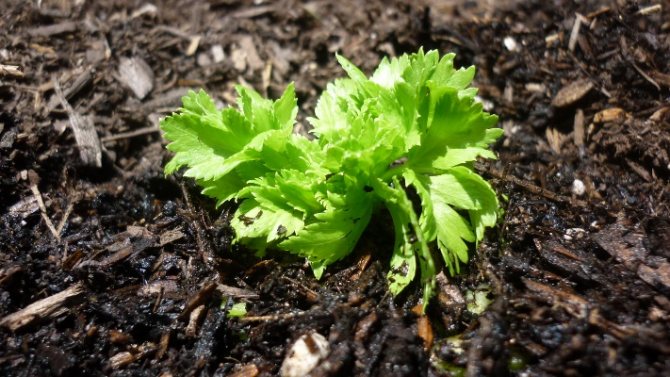

Mulching the soil helps to retain moisture. For this purpose, use straw or sawdust. Not all growers use this procedure. Most often they mulch the ridges in dry years.
Diving or how to do without it
From seeds sown in a common container, celery grows, which must be planted, because:
- By the time of planting, the plants have 4-5 large leaves - in tight quarters, the bushes interfere with each other's development.
- The roots will intertwine - it is difficult to disassemble them without injuring. This is especially dangerous for root celery.
Therefore, root celery is often planted so as not to dive. With the rest of the species in this regard, it is easier: if you want - sit down, there is no time to mess around - immediately sow in separate pots or in a cassette.
The procedure is not much different from the resettlement of seedlings of other crops. A master class on diving root celery - in the video:
There is an option when 2-3 seeds are planted in one glass.
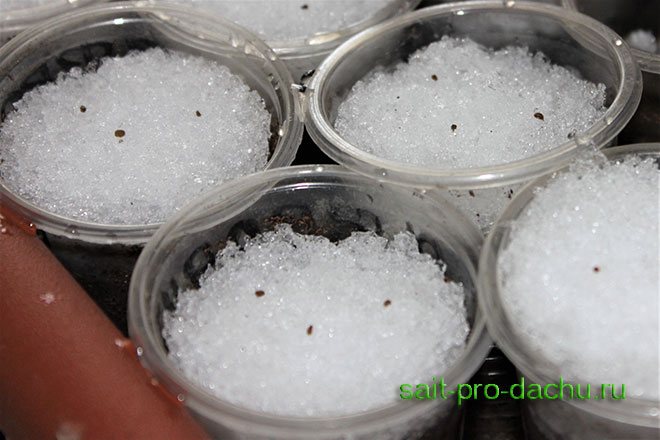

And when the seedlings reach the dive period (two carved real leaves), then the most promising one is chosen from the seedlings in each glass. The rest of the seedlings - do not pull out! - pinch off directly at the surface of the soil or cut off to zero with scissors.
Why can't you remove excess plants with roots? The roots in the ground are twisted, entangled with each other. By pulling on a weak seedling, you can disrupt the root system of a neighboring - selective one. Such an incorrect scheme for removing celery becomes the reason that the sprouts left for planting disappear.
And by cutting off the aerial part without disturbing the horses, the gardener stops the growth of weak shoots and the entire volume of the planting capacity is at the disposal of the chosen one.
In the frame - celery, planted in 3 pieces in cups on the snow (previous photo), after such a pick-plucking. This is what healthy seedlings look like after a dive.
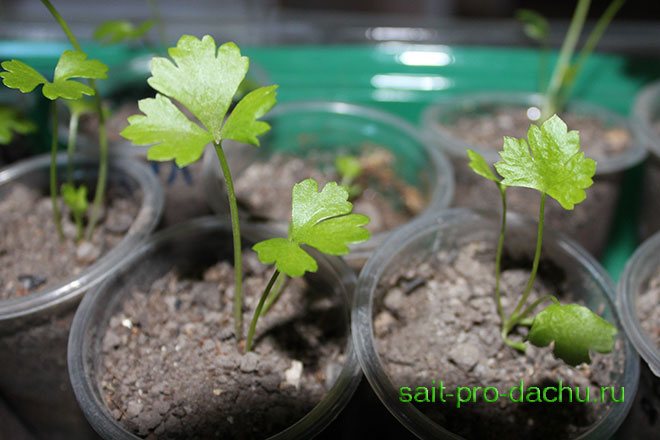

When and what to feed
To grow a good crop of stalked celery in the garden, you should not save on top dressing.
- The first is carried out after 10-14 days, the field of planting seedlings to a permanent place. Use organic fertilizers. For example, an infusion of mullein at the rate of one liter of fertilizer per five liters of water or bird droppings, prepared from one liter of fertilizer per ten liters of water.
- In the future, liquid top dressing of stalked celery is carried out every 10 days. To avoid an excess of nitrogen, four fertilizing with nitrogen-containing compositions are made and every fifth is performed using mineral fertilizers. A 2% solution of superphosphate or potassium salt will do.
- In the middle of summer, you can use complex fertilizers, which include potassium, magnesium, boron.
Two weeks before the expected harvest, feeding is stopped.
Contraindications
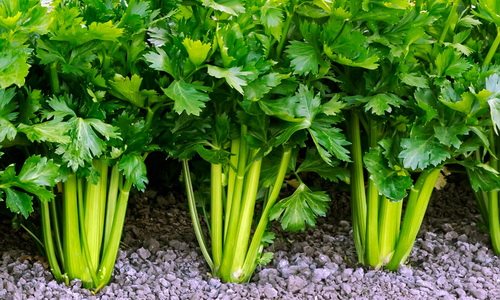

Celery should not be consumed in large quantities by people with kidney stones. The plant provokes the movement of stones, and this condition may require urgent medical attention.
Due to the content of specific essential oils, celery can harm people with colitis and enterocolitis.
It is believed that celery can trigger an epileptic seizure. In this disease, the plant must be used with caution. Do not overuse celery dishes when:
- thrombophlebitis;
- varicose veins;
- uterine bleeding;
- flatulence;
- allergies.
Celery taste affects breast milk.So that babies do not refuse to feed, mothers do not eat this plant, like other spices.
Pregnant women should not eat a lot of celery. The plant contains substances, a large amount of which stimulates the contractions of the uterus.
Petiole whitening
When growing many varieties, a procedure such as bleaching the petioles will be required. It is performed to enhance the palatability.


More recently, gardeners of this kind were grown in peculiar trenches and huddled during the summer, gradually covering the stems with earth. Nowadays, a different method is being used more and more often.
A few weeks before harvesting, the leaves are carefully pulled into bunches with strips of cloth, and the stems are covered with paper, burlap or lutrasil. You can use dark plastic bottles. It is advisable to pour sawdust or dry foliage into them.
Attention!
Do not wrap stalks of stalked celery with foil. With a lack of oxygen, he will die.
How do you know when it's time to start bleaching? By this time, new leaves in the rosette stop forming, the stems reach a height of 30-35 cm and thicken.
Uses of leaf celery
Leaf celery is widely used in cooking and traditional medicine. Low calorie content and the ability to remove excess fluid from the body make it an indispensable aid in the process of losing weight.
In cooking
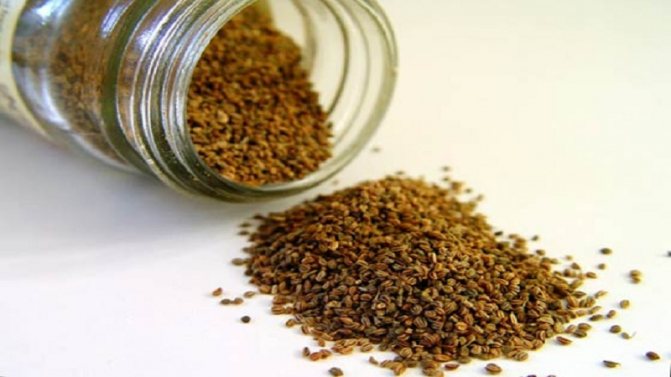

Celery leaves are used as a fragrant spice. Greens are added to salads, side dishes of vegetables and cereals, soups, broths, and used to decorate dishes.
Green salad with nuts
Juicy, refreshing and moderately spicy salad will appeal to lovers of light, low-calorie dishes.
Ingredients:
- lettuce leaves - 500 g;
- green onions - 100 g;
- celery leaves - 1 bunch;
- celery stalks - 2 pcs.;
- parsley, dill - to taste;
- pine nuts (walnuts) - 50 g;
- pitted green olives - 8-10 pcs .;
- olive oil - 2 tablespoons l .;
- lemon juice - 1 tbsp. l .;
- Dijon mustard - 1 tsp;
- honey - 1 tsp;
- salt, pepper - to taste.
Preparation:
- Wash lettuce and herbs, dry on a paper or waffle towel. Tear the salad with your hands, chop the herbs with a knife.
- Finely chop the olives.
- Dry the nuts in a dry frying pan.
- Mix oil, lemon juice, mustard, honey, salt and pepper and season the salad.
Salad with tuna
This salad is excellent nourishing, has a light spicy aftertaste and aroma.
Ingredients:
- tuna in olive oil - 125 g;
- celery greens - 1 bunch;
- champignons - 100 g;
- Tabasco sauce - 1 tsp;
- Dijon mustard - 1 tsp;
- salt, pepper - to taste;
- lemon juice - 1 tbsp. l.
Preparation:
- Open a can of tuna, drain the oil into a bowl, and chop the fish with a fork.
- Wash the mushrooms, dry, bake in the oven for 5-10 minutes, cut into pieces.
- Rinse celery greens under the tap and dry.
- In a bowl, mix canned oil, lemon juice, mustard, tabasco with salt and pepper, season the salad.
In folk medicine
In folk medicine, celery root is mainly used. Its freshly squeezed juice is recommended for gastritis, stomach ulcers, liver dysfunctions, flatulence.
Greens help with gout and rheumatism. The leaves and finely chopped root are folded into a thermos, poured with boiling water and insisted for 3-5 hours. The infusion is used for rubbing sore spots and compresses.
Dried herb tea is an excellent diuretic. It dissolves salt in the body, heals colds, calms the nervous system. For its preparation 2 tbsp. l. dry leaves pour 500 ml of boiling water and bring to a boil over low heat. No more than two glasses of tea are taken per day.
Ointment from stems and leaves heals purulent wounds, rashes, ulcers, urticaria, lichen, eczema. Fresh stalks together with leaves are passed through a meat grinder and mixed in equal proportions with melted butter. The product is applied to the affected areas and covered with clean gauze.A jar of ointment is stored in the refrigerator.
Slimming
With the aim of slimming use fresh petioles and greens. The products are put in a blender and chopped thoroughly. The drink is drunk neat or mixed with apple, carrot, orange juice.
Nutritionists recommend including fresh celery in the daily diet of obese people.
Celery dishes are suitable for a short-term diet of three days.
Advice. Instead of the usual fried soup in vegetable oil, prepare a dietary Bonn soup based on white cabbage, tomatoes, onions, bell peppers, celery and parsley.
Features of growing in greenhouse conditions
Growing and caring for stalked celery in a greenhouse is no different from growing crops in open beds. The only thing worth paying attention to is the temperature. At low temperatures, it is prone to shooting and premature flowering. When too tall, the plants stretch out and their stems become thinner.
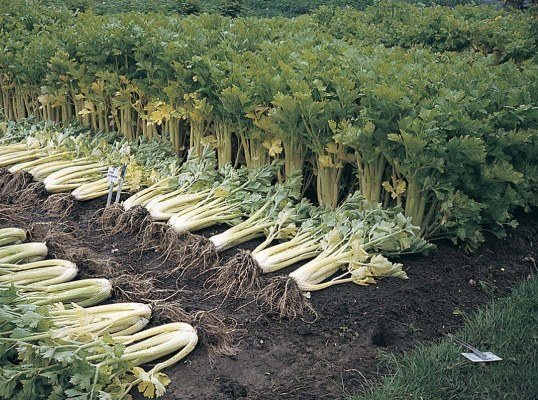

Varieties
There are three known varieties of celery:
- Root... It is appreciated for a root vegetable, which is used for garnishes for dishes, dried, frozen pulp. Saturated with vitamins, amino acids, and other useful elements, it is used for salads and hot dishes. They are grown only by the seedling method. Belongs to late varieties, it takes an average of 170 days to ripen. The root crop weighs 500-900 grams (example - in the photo).
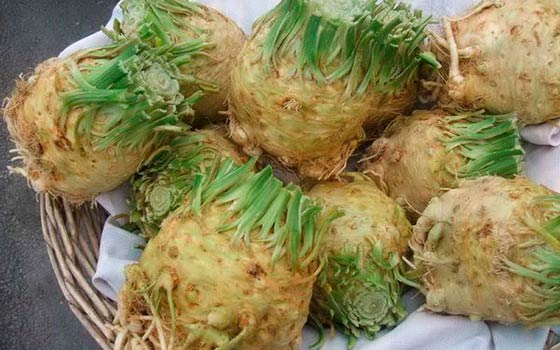

- Petiolate - salads and fresh juices - the main purpose of growing celery for the sake of long thick stalks.
- Sheet - grown to produce fragrant greens saturated with essential oils. In leafy celery, the top is the main part. Fragrant, fragrant greenery, with an underdeveloped root system. Carved leaves are a great addition to any salad. Leafy celery has a peculiar taste: tart, bitter, spicy. Resistant to dryness and low temperatures, in the south it is grown from seeds planted directly into the ground.
Diseases and pests
When growing and caring for stalked celery in the open field, it is worth periodically inspecting the leaf sockets for the appearance of diseases. Most often they are affected by various kinds of spots. Among them are cercosporiasis, septoria or rust. All diseases can be easily dealt with with phytosporin or various fungicides.
Most pests are repelled by the smell of the plant. Most often it is threatened by snails and slugs. Weeding and loosening the soil regularly will prevent pests from emerging.
Celery: sowing seeds, seedlings and planting in the garden
Growing features
In order for celery to delight you with aroma, taste, and strong stems, you should take into account the specific characteristics of the plant and know the rules for its cultivation. Not only the harvest will depend on the knowledge gained, but also the taste, as well as the amount of nutrients in the vegetable.
The area for growing this vegetable crop must be open, then the plant will be able to absorb maximum sunlight. In slightly shaded areas, celery also grows successfully, and, most surprisingly, it becomes more aromatic.
One of the positive characteristics of the vegetable is its resistance to light frost, and some varieties can tolerate frosts up to -5 degrees, these types include red-stalked celery.
It is believed that the temperate climate is ideal for the plant, so many vegetable growers in central Russia successfully grow it on their backyards.
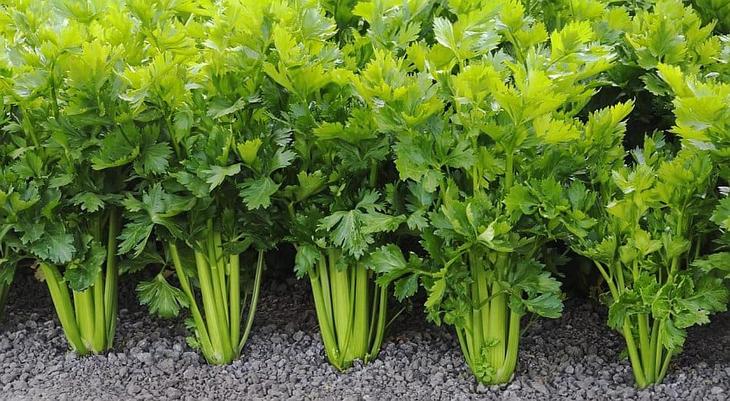

The plant prefers fertile and loose soil, which, due to the drainage layer, is able to retain water, which is required for the growth of succulent stems and root crops in fairly large quantities.Under the condition of increased acidity of the soil, it should be deoxidized with dolomite flour or slaked lime before the planting procedure in two weeks.
Please note that close proximity to parsnips can cause a myriad of pests such as the celery fly, which is a common enemy for both species.
We will get acquainted in more detail with agrotechnical rules a little later, when we talk about planting a plant in open ground.
Varieties of celery
- The leafy look is of interest to gardeners for its leaves, used as an additive in fresh salads, in the preparation of various savory sauces and first courses. The difference between leafy species is that, compared to root species, they yield greenery up to several times over the summer. After cutting, the foliage grows quickly and continues to delight the gardener with its lush rosette. The usefulness of celery is obvious, the foliage contains such a valuable substance as beta - carotene and vitamin C. The last component is present in celery in such an amount that it outstrips the amount of the same vitamins found in citrus plant species. Celery foliage serves as a sedative, successfully removes toxins from the body, works against inflammatory processes, and has a diuretic effect.
- The petiolate species has large stems, and it is for them that it is grown. Different varieties of stalked celery can have from 250 g to 1 kg of useful and juicy mass from one plant, which is also used in cooking for the preparation of various dishes. The petioles contain a huge number of components useful for human health, this is fiber, and mineral salts, and vitamin groups: B, C, A, K. This vegetable is the champion among gardeners in terms of the amount of phosphorus, and the calcium, potassium present in it, zinc, iron and magnesium serve as a real “building material” for the skeletal system and a stimulus for the normal functioning of organs and systems. The low calorie content of the product allows it to be used as a diet food, because 100 g contains only 7 kcal. Petiolate varieties can be used raw, boiled, baked and fried.
Both types contain essential oils, it is they who give the plants aroma and characteristic taste. Due to them, digestive processes are stimulated, and appetite increases.
Wherever celery is not used: in soups, sauces, pates, when preserving vegetables and other products. It can be dried, frozen and of course used fresh in unlimited quantities.
For central Russia, the most suitable are petiole varieties: Golden, Malachite. And among the leafy ones, one can note: Zakhar, Kartuni.
It must be understood that all varieties and hybrids of celery presented today on the domestic market differ both in their characteristics and in terms of ripening periods, therefore, when buying seeds, you should carefully read the plant data.
Some varieties require that they be grown through seedlings, so we will dwell on this process and consider it in detail.
How to grow celery seedlings
Celery is considered a biennial plant, in the first season it builds up the root system and the leaf rosette is not powerful enough, but in the second year of life it shows all its best qualities and turns into a huge and bright green rosette.
With the seedling method, it is possible to obtain the desired amount of product in the first year. For this, the seeds must undergo preliminary preparation. The optimal time for planting seeds is March.
- The planting material must be soaked in warm water for three days, so they can germinate and, when planted in the soil, will sprout faster.
- The soil for seedlings must be made loose, the composition must include: humus, peat and sand.
- After soaking, the seeds are not embedded in the soil, but spread over its surface. A thin layer of peat is sprinkled on top. Before and after planting, the soil must be moistened with a spray bottle.
- Further, containers with seeds should be covered with foil and placed in a warm place. For seedlings, a temperature of at least +20 degrees is required.
- After the emergence of seedlings, and this will happen on the 5-7th day, the film can be removed, and the temperature regime should be reduced to + 15 degrees, otherwise the seedlings may stretch out and fall.
- Moistening the soil is one of the main conditions for the successful cultivation of celery seedlings.
After the appearance of real leaves, you can start picking and planting seedlings in separate cups. When transplanting, do not deepen the plants too deeply, the rosette should not be covered with earth. After picking, the plants should be placed on a sunny windowsill, so they will feel very comfortable.
After the return frosts have ended, you can determine the plants in open ground. In all regions, this period occurs at different times, so each gardener is guided by the climatic conditions characteristic of the area.
Planting in the beds
As for any other plant, it is best to prepare the beds for celery in the fall, put all the necessary components in the soil: organic matter, mineral fertilizers, then by spring it will be completely ready for planting.
For stalked celery, there is the following sequence of actions:
- For this species, a lot of nitrogen is needed, therefore, in the spring, mineral fertilizer must be applied to the area where the vegetable will grow, and a month later, after planting the seedlings, feed it with nitrogen fertilizing.
- When planting seedlings, the rosette should be left above the soil surface, and as the shoots grow, fill it up.
- Loosening and moisture are the necessary items that are necessary for this species.
- To fill the stalks with juice and acquire them white, do the following: when the stems grow 30 cm, carefully tie them in a bundle and wrap them in dark paper, make something in the form of a vase with leaves peeping out from above.
- Before the winter period, petiole varieties are covered with mulch in the form of straw or needles.
There are varieties that bleach themselves, you do not need to tie them, for this it is enough to lay the straw next to it with a layer of 15 cm.
Unlike the petiole species, leaf celery can be planted directly into the ground, and after two months you can get a full harvest of leaves. Remember that getting lush fresh greens requires regular moisture and weeding.
For effective feeding, a solution based on: from humus, manure, compost, fermented grass, vermicompost and mineral complex fertilizer is suitable.
Harvesting
The harvest of stalked celery is started following the dates indicated on the seed packaging. When outgrowing, the petioles become stiff. Plants grown in open beds are harvested before the first frost.
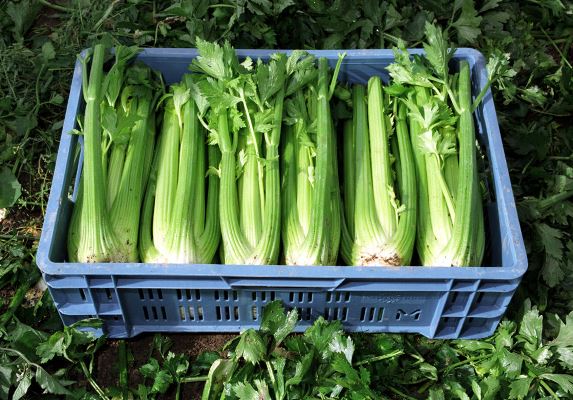

The rosettes are carefully dug up and the roots are cut. If there is a possibility of storage in the cellar, the roots are left. The vegetable is placed in a box and covered with earth. So the petioles can be stored for up to two months.
The author of the video will tell you how to grow stalked celery.
How to grow seedlings?
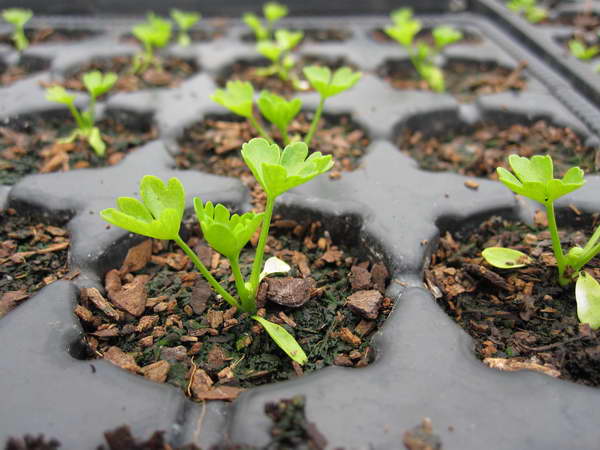

Celery seeds soaked in essential oils do not germinate for a long time. To accelerate this process requires the destruction of inhibitors of germination inhibitors.
This problem can be solved in several ways:
- In 3 divided doses, alternately soak the seeds in hot water up to + 50 ° С and cool temperatures around + 18 ° С. The seeds are kept in hot water for 5 and 10 minutes, respectively (the first and second time) and until the water cools down - for the third time.
- Germinate for 7-10 days.The seeds are soaked, put after swelling on a damp cloth and placed in the refrigerator.
It is recommended to sow prepared stalked celery seeds in boxes of shallow depth, in loose soil based on humus and peat. There is no need to close them up after sowing: the seeds need light to germinate.
To ensure a good adhesion to the soil substrate, it is recommended to spray them with water from a spray bottle. Covering with a layer of snow is also effective, which, when melted, slightly pulls them into the ground.
Covering the box with foil or glass, put it in a bright, warm place, for example, on a windowsill. After the appearance of thin seedlings, it is recommended to sprinkle them with earth for half a centimeter, and remove the film.
Seedling care
To prevent damage to fragile seedlings, crops are carefully watered through a strainer or from a spray bottle. At the stage of 2-3 true leaves, the plants dive, pinching off the central root by a quarter. Plastic cups can be used as containers. Seedlings are deepened to cotyledon leaves.
For several days, the cut seedlings are protected from direct sunlight, and after taking root, they are again placed on the windowsill.
Before planting in the ground, it is recommended to harden the plants, which must be started at an air temperature of at least + 10 ° C. First, it is taken out at noon, then from morning until 4-5 o'clock in the afternoon. If the weather permits, the plants are left outside overnight a week before planting.

